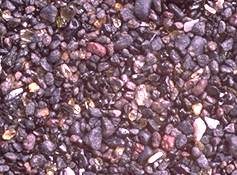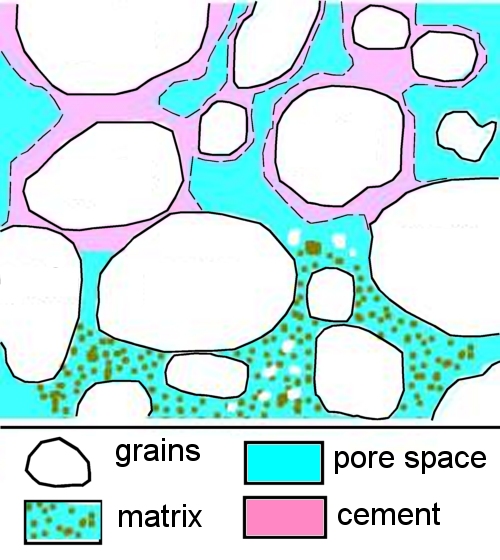 |
 |
Please note
Four main groups of sediments and sedimentary rocks may be defined:
What are the terrigenous clastic rocks? They are mixtures of mineral grains & rock fragments derived by weathering & erosion of pre-existing rocks. These processes are just one small part of the Rock Cycle.
These include:
2. and 3. are particularly important in modifying the mineralogy of the sediment produced from the original source rock. For example, common changes at earth surface temperatures and pressures are:
| feldspars | clay minerals | ||
| mafic minerals | chlorites + ions in solution |
Unstable minerals include: pyroxenes, olivines, amphiboles, some plagioclase feldspars. In fact, many high temperature and/or high pressure igneous and metamorphic minerals are not stable under the low temperatures and pressures typical of sedimentary environments. Many igneous minerals, particularly the mafic ones and Ca-rich feldspars, are susceptible to chemical weathering: they break down, and are not commonly found in sedimentary rocks. So, if you think you have found pyroxene or olivine in a sandstone, double check your identification!! It is possible to find such minerals in sands and sandstones close to their source areas (e.g. black sand beaches on volcanic islands), but not common.
Stable minerals include quartz, K-feldspar, Na-feldspar, muscovite, clay minerals, some 'heavy minerals' (e.g. some garnets, zircon, tourmaline etc.).
Mechanical durability is also important. Minerals which are hard, or which have no cleavage, are likely to survive longer: they are more resistant to abrasion during transport.
Quartz is by far the most common of these stable, durable minerals, and the commonest component in clastic sediments. It survives because of its resistance to chemical attack (it is soluble only in highly alkaline solutions), and its mechanical durability (hardness 7, no cleavage).
The concept of mineralogical maturity: a mineralogically mature sediment or sedimentary rock is one which consists largely of the stable minerals, particularly quartz. Mineralogically mature rocks are those which have undergone prolonged weathering, transport and reworking.
These rocks can be regarded as having four components:
 |
This is a cartoon view of a sandstone in thin section. It
illustrates the four components:
|
You will already be familiar in thin section with most of the grains that you are likely to come across in sandstones: many of them are also found in igneous rocks. In some cases, it may also be possible to recognize different types of the same mineral, such as varieties of quartz.
A problem with sedimentary grains is that, because of transport & abrasion, they rarely show crystal faces, so we often do not have crystal shape or straight or inclined extinction as identifiable properties.
This page contains detailed information on the occurrence and recognition of minerals and other components in sedimentary rocks. It is also available as a printed handout.
|
Boggs, 1995, pp. 158-162, 168-173: Sandstone mineralogy Tucker, 1991, pp. 38-47 |
|
|
Boggs, 1995, p. 183-185: Provenance Tucker, 1991, pp. 53-55 |
|
|
Note: all references to Boggs, 1995 and Tucker, 1991 in these pages refer to: BOGGS, S. 1995. Principles of Sedimentology and Stratigraphy (2nd edition). Prentice Hall. TUCKER, M.E. 1991. Sedimentary Petrology (2nd edition). Blackwell. |
So far, we have considered the composition of the grains. Now let us move on to the matrix - the mud-sized sediment between the grains in many clastic sediments and rocks. Surprisingly, it is often possibly to determine the mineralogy of this fine-grained material by careful examination under high magnification. It may contain silt-sized quartz grains, and one or more clay minerals. The properties of the common clay minerals are described in Mineralogy of clastic rocks, and in Clay Minerals.
Clays are seen better under the scanning electron microscope (SEM).
Clays minerals such as chlorite, illite and kaolinite are of great economic interest because of their effects (usually detrimental) on porosity and permeability of sedimentary rock
Chemically precipitated material, whether a new mineral, or an addition to an existing mineral, may form a cement, which binds the grains of the sediment together to form a rock.
Sandstones are named and classified according to their composition. This is usually defined in terms of the percentage of matrix present, and the proportions of the different grain types (commonly quartz, feldspar and rock fragments). We shall use Dott's classification, which involves grain composition and percentage matrix, but ignores cement.
This page was written by Roger Suthren
Last Modified: 22 November, 2021